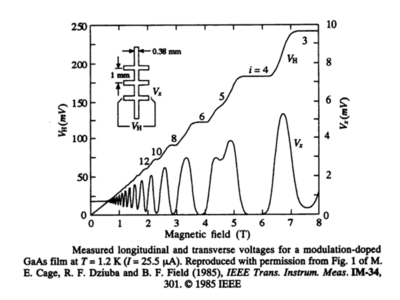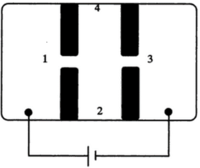Homework Set 3
Problem 1: Shubnikov-de Haas oscillations in 2DEG in high magnetic field
The physical properties of a 2DEG can be measured by embedding it into a multiterminal Hall bridge, as shown in the Figure above. The energy spectrum of 2D electrons in magnetic field orthogonal to such bridge consists of discrete Landau lavels:
,
which are well-separated for large enough B. Thus, the step-like density of states associated with 2DEG ( is the lowest level in the triangular potential that confines 2DEG) is then broken up into a series of peaks spaced by :
. (1)
Although the spikes are ideally delta functions, scattering processes spread them out in energy. As one changes the magnetic field B, longitudinal voltage (from which one computes the longitudinal resisitivity ) in the Figure above goes through one cycle of oscillations as the Fermi energy moves from the center of one Landau level to the center of the next Landau level. These oscillations are refered to as the Shubnikov-de Haas (SdH) oscillations.
(a) Devise a procedure that will allow you to extract electron density in 2DEG from the values of magnetic field B at which (or the corresponding ) reaches maximum in the course of SdH oscillations.
(b) What is for the 2DEG in the Figure above?
HINT: From Eq. (1) we see that the number of occupied Landau levels is , if electron density is already known.
Problem 2: Sharvin formula for classical point contact conductance
The Sharvin formula for the electrical conductance of an extremely short contact area between two pieces of metal is given by
where is the Fermi wavelength. Derive the Sharvin formula by considering the total current flowing through a hole of area in a thin insulating barrier separating two free electron gases with different Fermi energies, as shown in the Figure above. The gas on the left has Fermi energy , while the gas on the right has Fermi energy , where is the applied voltage bias.
Use purely macroscopic arguments:
1) The total current through the contact is
where current density along the z-axis is (carried by electrons within the bias window to ):
.
2) In a free electron gas, the number of electrons with energies between and traveling at an angle between and with respect to a given axis is
,
where is the density of states in three dimensions.
Problem 3: Finite temperature effects on conductance quantization in quantum point contacts
When the size of the point contact from Problem 2 becomes comparable to the Fermi wavelength , the contact enters the quantum regime where its conductance becomes quantized, as explained by the Landauer formula:
and observed experimentally in the Figure on the left. Here is the number of open "conducting channels", whose transmission is perfect [ is the step function] since in ballistic wires a channel is either open (when the Fermi energy is above the bottom of the corresponding subband) or closed (otherwise). One can also view the Sharvin formula from Problem 3 as a limiting case of such Landauer formula where the number of channels (in three dimensions) is very large, so that is a continuous function of and temperature is set to zero, .
Suppose that a quantum point contact (QPC) can be modeled by a 2D strip with hard-wall boundary conditions in the direction transverse to the current flow. The width of the strip is nm and the effective mass of electrons is of the bare electron mass (which is the case for GaAs heterostructures).
a) Plot the conductance of the quantum point contact as function of the Fermi energy for a number of temperatures . For the plot you can select an interval of Fermi energies encompassing up to 5 subband bottoms determined by the hard-wall boundary conditions as . Express all relevant energies in your plot ( along the x-axis, as parameter, and as discrete energies along the x-axis at conductance jumps at zero temperature in steps of ) in units of eV.
b) Using your plot or analytical considerations, determine characteristic temperature(s) at which features of the quantization plateau begin to disappear. In the latter case, for simplicity, you can consider only the first two subbands (i.e., conducting channels), to obtain explicit analytical expression for . How does your conclusion compare to experimental observation, shown in the Figure on the left, of washing out of quantized conductance steps with increasing temperature?
Problem 4: Magnetotransport in two quantum point contacts in series
In semiclassical electronic transport theory, the conductance of two QPCs in series, illustrated in Figure on the left, is half of that of a single quantum point, so that according to Problem 3 and at zero temperature . However, if two QPCs are sufficiently close together than the electrons emerging from one QPC do not have the chance to spread out before they reach the second QPC. Consequently, the conductance is the same as that of a single QPC, .
But if we turn on an external magnetic field, then the electrons get deflected and conductance is reduced, see Phys. Rev. B 39, 10445(R) (1989) and Phys. Rev. B 41, 8461 (1990). Using the Büttiker formula for multiterminal phase-coherent nanostructures, show that conductance is given by:
Failed to parse (syntax error): {\displaystyle G = \frac{e^2}{h} \left[ N_\mathrm{open} + T_F + \frac{(T_R - T_L)^2}{2T_F^'+T_R+T_L}] }
where the transmission functions are , <math> T_{42}






![{\displaystyle g(E,B)={\frac {2eB}{h}}\sum _{n=0}^{\infty }\delta \left[E-E_{b}-\hbar \omega \left(n+{\frac {1}{2}}\right)\right]}](https://en.wikipedia.org/api/rest_v1/media/math/render/svg/da67a12c70cfc7b2f3b6c17194680db2f42554b5)













































